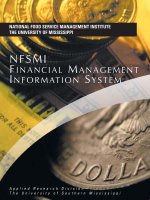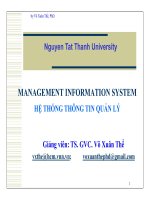Management information system ralp 7e ch07
Bạn đang xem bản rút gọn của tài liệu. Xem và tải ngay bản đầy đủ của tài liệu tại đây (1.59 MB, 45 trang )
• The Internet is like many other technologies—it provides a
wide range of services, some of which are effective and
practical for use today, others are still evolving, and still
others will fade away from lack of use
• Briefly describe how the Internet works, including
alternatives for connecting to it and the role of Internet
service providers
Principles of Information Systems, Seventh Edition
2
• Originally developed as a document-management system,
the World Wide Web is a menu-based system that is easy to
use for personal and business applications
• Describe the World Wide Web and the way it works
• Explain the use of Web browsers, search engines, and other
Web tools
• Identify and briefly describe the applications associated
with the Internet and the Web
Principles of Information Systems, Seventh Edition
3
• Because the Internet and the World Wide Web are becoming
more universally used and accepted for business use,
management, service and speed, privacy, and security issues
must continually be addressed and resolved
• Identify who is using the Web to conduct business and discuss
some of the pros and cons of Web shopping
• Outline a process for creating Web content
• Describe Java and discuss its potential impact on the software
world
Principles of Information Systems, Seventh Edition
4
• Define the terms intranet and extranet and discuss how
organizations are using them
• Identify several issues associated with the use of networks
Principles of Information Systems, Seventh Edition
5
Use and Functioning of the Internet
• Internet: a collection of interconnected networks, all
freely exchanging information
• ARPANET
• Ancestor of the Internet
• A project started by the U.S. Department of Defense (DoD)
in 1969
Principles of Information Systems, Seventh Edition
6
Use and Functioning of the Internet
(continued)
• Internet Protocol (IP): communication standard enabling
traffic to be routed from one network to another as needed
• Research for a faster Internet: Internet2 (I2); Next
Generation Internet (NGI); Abilene
• Wireless Internet
Principles of Information Systems, Seventh Edition
7
How the Internet Works
• The Internet transmits data from one computer (called a
host) to another
• If the receiving computer is on a network to which the first
computer is directly connected, it can send the message
directly
• If the receiving computer is not on a network to which the
sending computer is connected, the sending computer
relays the message to another computer that can forward it
Principles of Information Systems, Seventh Edition
8
Figure 7.1: Routing Messages
over the Internet
Principles of Information Systems, Seventh Edition
9
How the Internet Works (continued)
• Data is passed in chunks called packets
• Transmission Control Protocol (TCP): widely used
transport layer protocol that is used in combination with
Internet Protocol (IP) by most Internet applications
• Uniform Resource Locator (URL): an assigned address
on the Internet for each computer
Principles of Information Systems, Seventh Edition
10
Accessing the Internet
• Connect via LAN server
• Connect via Serial Line Internet Protocol (SLIP)/Point-toPoint Protocol (PPP)
• Connect via an online service
• Other ways to connect (e.g., wireless application protocol,
or WAP)
Principles of Information Systems, Seventh Edition
11
Figure 7.3: Several Ways to
Access the Internet
Principles of Information Systems, Seventh Edition
12
Internet Service Providers
• Internet service provider (ISP): any company that
provides individuals or organizations with Internet access
• Most charge a monthly fee
• Many ISPs and online services offer broadband Internet
access through digital subscriber lines (DSLs), cable, or
satellite transmission
Principles of Information Systems, Seventh Edition
13
The World Wide Web
• World Wide Web: AKA the Web, WWW, or W3
• A menu-based system that uses the client/server model
• Organizes Internet resources throughout the world into a
series of menu pages, or screens, that appear on your
computer
• Hypermedia: tools that connect the data on Web pages,
allowing users to access topics in whatever order they wish
Principles of Information Systems, Seventh Edition
14
The World Wide Web (continued)
• Hypertext Markup Language (HTML): the standard
page description language for Web pages
• HTML tags: inform browsers how to format text on a
Web page, and whether images, sound, and other elements
should be inserted
• Extensible Markup Language (XML): markup language
for Web documents containing structured information,
including words, pictures, and other elements
Principles of Information Systems, Seventh Edition
15
Figure 7.4: Sample Hypertext
Markup Language
Principles of Information Systems, Seventh Edition
16
Web Browsers
• Web browser: software that creates a unique, hypermediabased menu on a computer screen, providing a graphical
interface to the Web
• The menu consists of graphics, titles, and text with
hypertext links
Principles of Information Systems, Seventh Edition
17
Search Engines
• Search engine: a Web search tool
• Examples of search engines: Yahoo.com; Google.com
• Most search engines are free
• Searches can use words such as AND and OR to refine
the search
• Meta-search engine: submits keywords to several
individual search engines and returns the results from all
search engines queried
Principles of Information Systems, Seventh Edition
18
Table 7.5: Popular Search Engines
Principles of Information Systems, Seventh Edition
19
Web Programming Languages
• Java
• Object-oriented programming language from Sun
Microsystems based on C++
• Allows small programs (applets) to be embedded within an
HTML document
Principles of Information Systems, Seventh Edition
20
Web Programming Languages
(continued)
• Other programming languages used to develop Web sites:
• JavaScript
• VBScript
• ActiveX
• Hypertext Preprocessor (PHP)
Principles of Information Systems, Seventh Edition
21
Business Uses of the Web
• Linking buyers and sellers
• Tool for marketing, sales, and customer support
• Push technology: automatic transmission of information
over the Internet rather than making users search for it with
their browsers
Principles of Information Systems, Seventh Edition
22
Developing Web Content
• Computer must be linked to a Web server
• Need Web browser program
• Add links to home page
• Advertise
• Tools: word processor, HTML editor, HTML template, text
editor
Principles of Information Systems, Seventh Edition
23
Web Services
• Web services: standards and tools that streamline and
simplify communication among Web sites for business and
personal purposes
• XML is used within a Web page to describe and transfer
data between Web service applications
Principles of Information Systems, Seventh Edition
24
Web Services (continued)
• Besides XML, other components are used in Web service
applications:
• SOAP (Simple Object Access Protocol)
• WSDL (Web Services Description Language)
• UDDI (Universal Discovery Description and Integration)
Principles of Information Systems, Seventh Edition
25









